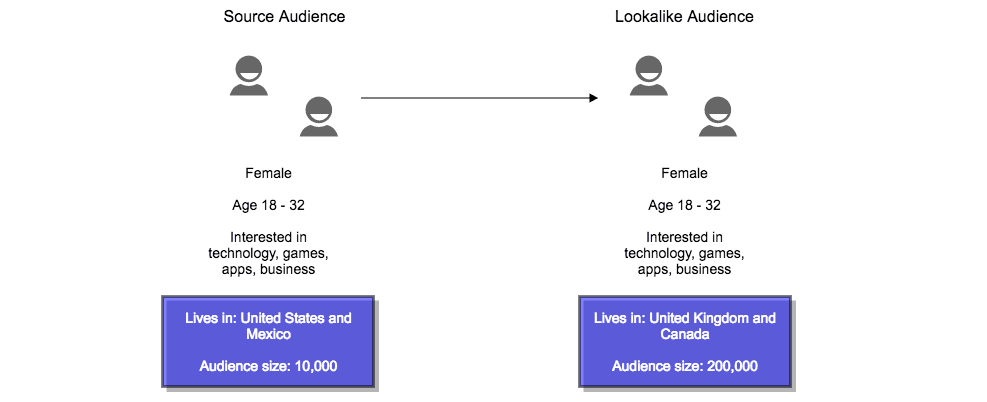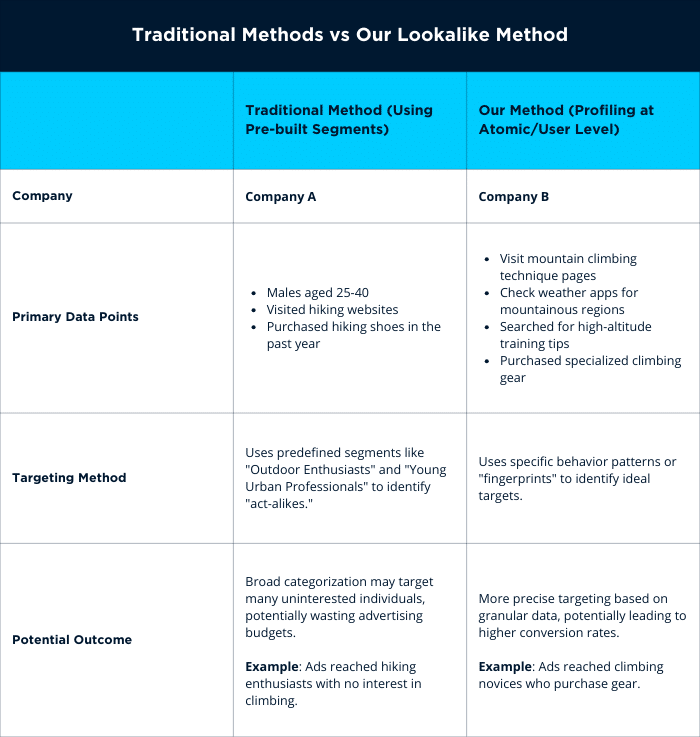Unlike traditional data models that make assumptions over using data, lookalike modeling takes data from your current and most valuable customers to identify ones with similar traits.
The outcome? A laser-focused marketing strategy that connects you to individuals more predisposed to engage with and buy from your brand.
This guide will help you understand the what, and why of lookalike modeling and how to use it to reach your target customers.
📑 Table of Contents
What is Lookalike Modeling?
Lookalike modeling identifies people who look and act just like your target audience. This model targets new potential customers who share traits with existing ones, increasing the likelihood of conversion.
Example: You run an online store selling eco-friendly athletic wear. Through research, you discover that many of your loyal customers are women aged 25-35 in urban areas. They frequently browse articles about marathon training and engage with content related to sustainable fabrics and materials.
With lookalike modeling, you can build an audience resembling your existing one and target them with specialized ads.

How Can Advertisers Benefit from Lookalike Modeling?
Lookalike modeling, rooted in First-Party (1P) data, provides a strategic edge. It outpaces traditional methods such as Third-Party (3P) data segments and contextual targeting by offering more precise and tailored audience identification based on your customers’ actual behaviors and attributes.
Let’s examine more benefits of lookalike modeling.
1. High-Quality Lead Generation
Your brand’s most valuable prospects are those who have already engaged with your product, whether making a purchase in a physical store or visiting your digital store to research your offerings.
You can utilize First-Party data from your existing customers to find potential customers as they will most likely be interested in your product or service and more likely to buy.
Data such as age, job title, and purchase history can be utilized to find your ideal customers. Not only does this increase lead generation, but also ensures your leads are of the highest quality.
2. Better Customer Understanding
Knowing your customers is the key to crafting personalized marketing campaigns that identify and target high-quality leads most likely to convert.
This not only increases the chances of immediate sales but also nurtures long-term relationships, leading to repeat business and enhanced customer lifetime value (CLV).
As customers feel understood and valued, they’re more likely to become your brand’s biggest advocates, amplifying your reach through word-of-mouth and organic referrals.
Example: A brand determines through deep behavioral profiling that many of their loyal customers not only support environmental causes but also frequently participate in city-based tree planting events, sign petitions for green urban initiatives, and research sustainable home products. The brand should craft campaigns promoting specific eco-friendly products or spotlight its own sustainability initiatives aligned with these precise interests.
📚 Related Article: The Data Maturity Model: Master Your Data in 5 Easy Stages: Read more about how you can get the most out of your customer data and, in turn, save you time and money for all your marketing efforts.
3. Precise Targeting Compared to Other Methods
Unlike Third-Party and contextual targeting, lookalike modeling offers a precise strategy based on shared characteristics and behaviors.
The Problem with Third-Party and Contextual Targeting
Third-Party audience segments rely on data aggregation companies with little oversight or transparency, so advertisers often face challenges in verifying data quality and relevance. Plus, with the deprecation of 3P cookies, advertisers shouldn’t rely entirely on this data for audience targeting.
Contextual targeting analyzes place (location) instead of person, hoping the algorithm delivers the ad to the right location with the right person sitting in front of the screen.
Lookalike modeling offers:
- High-Quality Lead Generation: You can better optimize your budget by targeting the right audience and reducing spend on irrelevant segments.
- Better Customer Understanding: You gain deeper insights into customer behaviors and preferences.
- Targeting Precision: You can match their message with like-minded audiences, booting engagement potential.
- Adaptability: Lookalike modeling adapts to a brand’s shifting customer base, keeping targeting strategies relevant.
Why is Lookalike Modeling Superior to 3P and Contextual Targeting?
“Lookalike modeling outperforms traditional digital marketing by leveraging an advertiser’s First-Party data to target users resembling their existing audience. Such precision in targeting usually results in enhanced performance because we’re reaching out to individuals who already mirror the attributes of an advertiser’s present clientele, increasing the likelihood of conversions.
Indeed, the numbers often affirm this. Introducing lookalike audiences into campaigns typically yields significantly better results compared to Third-Party and contextual strategies. Lookalike modeling is a strong strategy to maximize the value of your First-Party data, elevating your targeting by connecting with users that resonate closely with your existing customer profile.”
How Does Lookalike Modeling Work, and How Do You Build a Lookalike Audience?
Using lookalike modeling, you can find and connect with potential fans by analyzing the habits and interests of your current audience.
Below, we review how lookalike modeling works and how we at KORTX build lookalike audiences.
1. Data Collection
Each day, two primary sources gather 160 billion digital and real-world consumer data points: the programmatic bid stream and licensed ad-supported/non-ad-supported data. This includes unique website behaviors not found in the bid stream.
Every data collected carries a timestamp, enabling us to trace precisely when specific behaviors occur.
Using our proprietary KORTX Device Graph, we map this vast amount of information onto 800 million anonymous devices. This helps us know which device showed what kind of interest.

📱 The average home in the US owns 10 devices. We can reach them all.
Our device graph can help you reach every household device, from mobile to CTV, timely and effectively.
3. Cleaning and Updating the Data
Not all data is useful. So, we filter out the noise, keeping only the most reliable information. Our expert partners employ patented data science techniques, cleaning the gathered data to achieve a 99% human-verified rate, unparalleled in the industry.
To keep our information current and relevant, we refresh our audiences daily, far more frequently than the industry’s standard 30, 60, or 90-day intervals.
4. Crafting Custom Audiences
To understand your current customer base deeply, we use your First-Party data (e.g., tracking pixels, CRM (Customer Relationship Management), or CDP (Customer Data Platform)).
Analyzing data across 10 million locations and unique attributes, we craft a “behavioral fingerprint” to gain a deep understanding of an individual user’s behavior or preferences.
💡 It’s crucial to note that this method diverges significantly from the more conventional practice of comparing First-Party data against pre-set or “act alike” segments (e.g., “young urban professionals,” “retirees,” “new parents,” etc.), an approach we believe is biased because it relies on assumptions and generalizations.
5. Finding More Audiences
After spotting certain behaviors, we build a custom audience of users who act similarly but haven’t interacted with your brand. This audience model is updated daily using machine learning to include users signifying buying intent and exclude those no longer interested.
Every dollar you spend targets the right people based on today’s reliable data, not outdated or limited info from previous months.
6. Identity Confirmation and Cross-Device Connectivity
To make sure we’re targeting unique users, we have a special system that tracks both online browsing and mobile app activities.
This system, our KORTX Device Graph, can recognize users by either website data (cookies) or specific device numbers (device IDs), making sure our messages reach people on any of their devices. Internally, we can link website data (cookies) to specific devices.
📚 Related Article: The Art of Cross-Device Targeting: Learn more about how to future-proof your campaigns and reach every device in a home through cross-device targeting.
7. Adapting to Modern Browsing
Many people now browse without using cookies (tiny bits of data websites store on your device). We have that covered, too, drawing from First-Party data accumulated from your website and stored in our Axon Audience Manager.
Axon is a sophisticated audience management platform that uses First-Party data to create targeted and successful marketing strategies.
We can analyze First-Party data from Axon across domains, time of day, and locations to build an ID-less lookalike audience profile. This helps us reach users with ID numbers and those who can’t, using a brand’s specific customer data.
We help your message reach everyone in your target audience, cookies or not.
📚 Related Article: Welcome to the Cookieless Future: Testing & Tracking without Third-Party Data: Read more about targeting beyond 3P cookies and what you can do to protect your data from cookie deprecation.
How does KORTX create lookalike audiences better than other companies?
“KORTX has refined the art of crafting lookalike audiences using an intricate blend of First-Party data gleaned from Axon Audience Manager, advanced machine learning algorithms, and real-time user insights.
While other companies might rely on superficial metrics and audience-building assumptions, KORTX dives deeper, offering a holistic understanding of a brand’s core audience. This commitment to precision and personalization is what sets KORTX apart in delivering audiences that actually resonate with a brand’s values and objectives.”
What Do I Need to Get Started with Lookalike Modeling?
Starting with lookalike modeling requires a few starting components:
- First-Party Data: Begin with your own customer data. This can come from various sources like website analytics, CRM systems, or purchase histories. The more comprehensive and accurate this data is, the better your lookalike models will be.
- A Clear Objective: Understand what you aim to achieve with lookalike modeling. Are you hoping to boost sales, increase website traffic, or raise brand awareness? Defining a clear goal will guide the modeling process.
- A Reliable Partner: Consider partnering with a data science or marketing agency experienced in lookalike modeling. They can provide the necessary expertise, tools, and platforms to help.
Once you have these components, you can start your journey towards more targeted marketing campaigns!
Don’t Build Lookalike Audiences Alone, Hire a Partner With 8+ Years of Experience
Creating lookalike audiences takes time and expertise. That’s what KORTX, a leading provider of digital marketing solutions, is here for.
Save time and boost your success by partnering with us.
Lookalike Modeling: Continuous Refinement for the Future
Lookalike modeling isn’t a one-off task. It’s a continuous process that needs regular updates and maintenance. As the model operates, it gains a deeper understanding of your audience, refining its accuracy over time.
It uses the behavior and demographics of your current audience to help you expand your reach and connect with new potential customers, amplifying your business’s outreach and overall growth.
About the Author
Bryan Presti is the Head of Programmatic Trading at KORTX.



